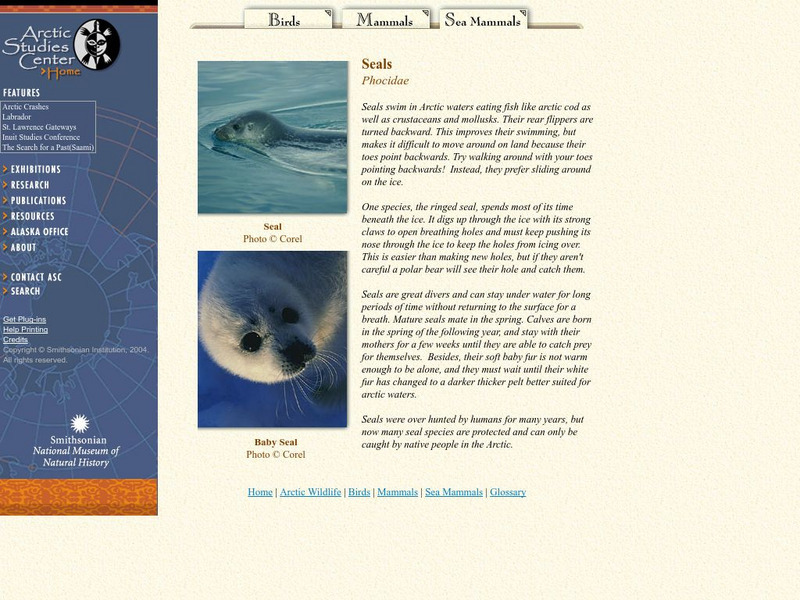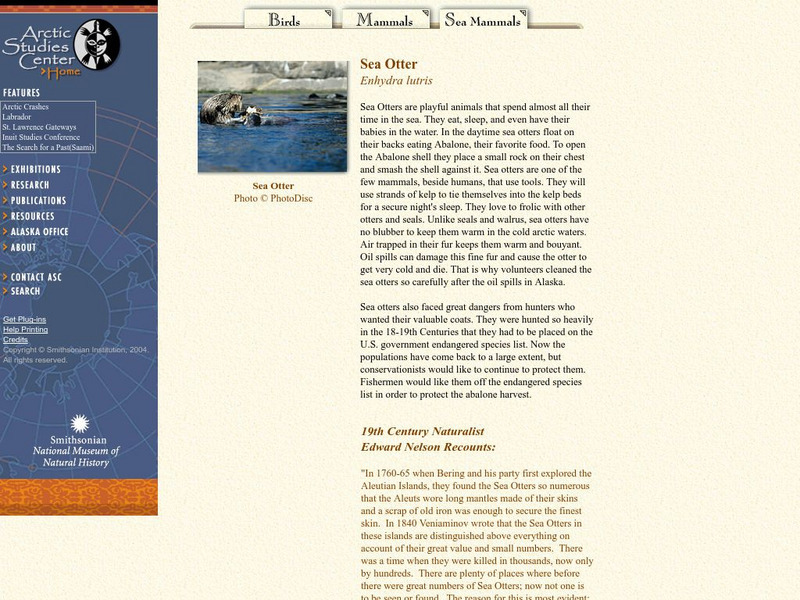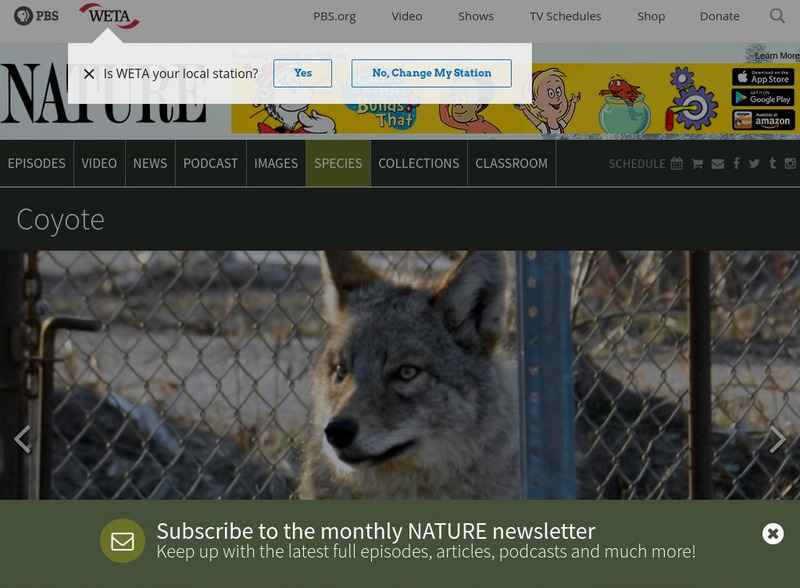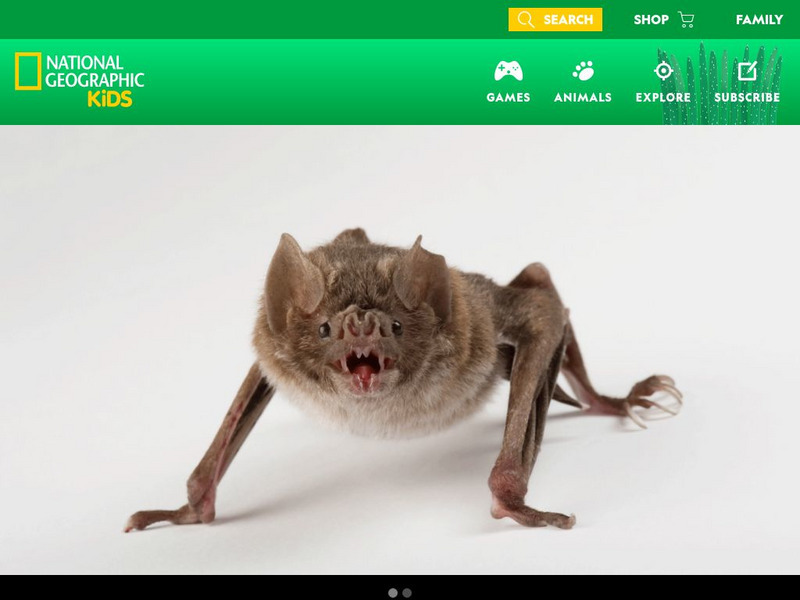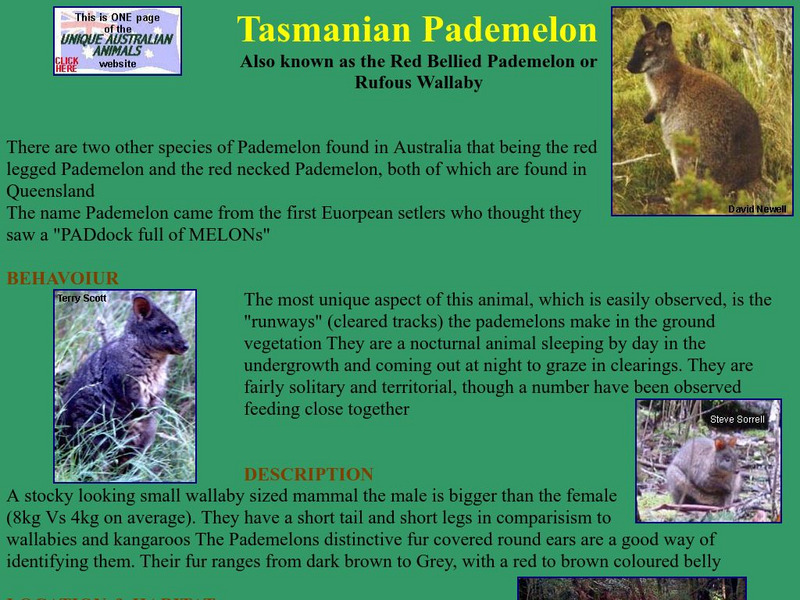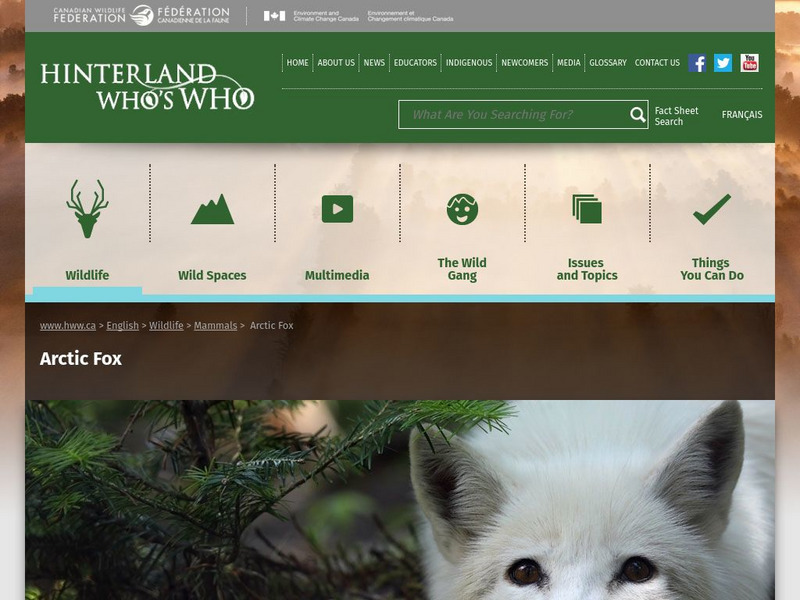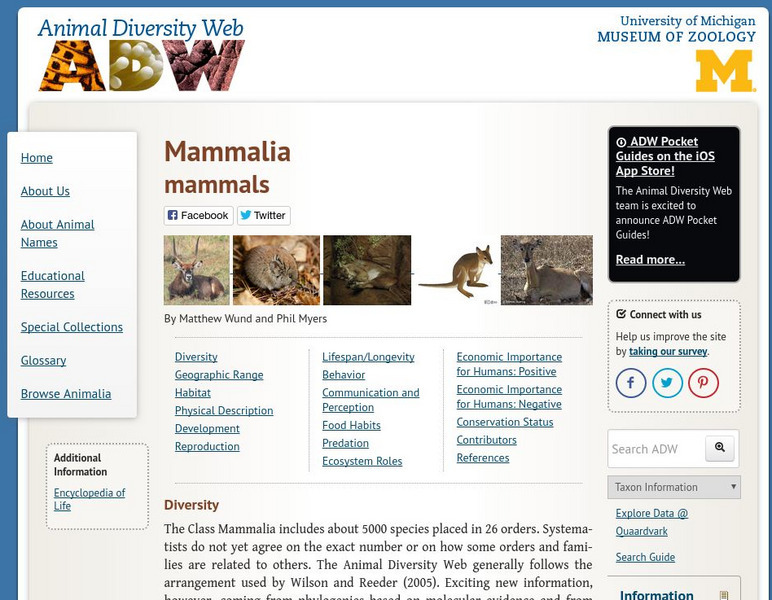Smithsonian Institution
National Museum of Natural History: Arctic Studies Center Mammals Seals
This Smithsonian website has a brief, but thorough, article on the Seal that also includes pictures.
Smithsonian Institution
National Museum of Natural History: Arctic Studies Center Mammals Sea Otter
This Smithsonian website has a brief, but thorough, article on the Sea Otters that also includes a picture and an extensive quote from naturalist Edward Nelson.
Globio
Glossopedia: Rhinoceros
Rhinoceroses, or rhinos, are big and ancient-looking and can be dangerous. They can also be shy and are seldom seen. Once there were hundreds of rhino species, but today there are only a few. This article provides an in-depth look at...
PBS
Pbs Nature: Coyote
What do you know about coyotes? Learn more about how adaptable this animal is to new surroundings when you check out this informative resource. Explore this website to find more facts and information ranging from what these animals eat...
Monterey Bay Aquarium
Monterey Bay Aquarium: Sea Otters
A resource that explores the otter's life at sea with emphasis on keeping warm, diet, social life, and mother and pup. A live cam is set up to view the sea otters. Other sites (Marine Mammals and Octopus's) can be accessed.
Sea World Parks & Entertainment
Sea World: Walrus
Walruses, members of the seal family of marine mammals, are profiled in detail with information about their classification, habitat, behaviors, and conservation. Other features include books for young readers.
Missouri Botanical Garden
Missouri Botanical Garden: Eurasian Beaver
Here you can learn all about the Eurasian beaver, a large European rodent that lives in the taiga biome. Content includes information on this animal's appearance, diet, behavior, and more.
Earth Life
Earth Life: Locomotion of Mammals
Good site for some general information on the movement of mammals. Gives a description and gives the average speed of a variety of animals.
Ducksters
Ducksters: Animals for Kids: Vertebrates
What is a vertebrate? Students learn about these animals that have backbones such as mammals, fish, birds, and reptiles.
Ducksters
Ducksters: Animals for Kids: Meerkat
Kids learn about the meerkat, ground dwelling African mammal that lives in complex family clans.
National Geographic Kids
National Geographic Kids: Animals: Harp Seal
A profile of the harp seal for the younger researcher. Video clip and map of habitat and range plus details of the young, food, mating, and enemies are included.
National Geographic Kids
National Geographic Kids: Animals: Vampire Bats
Great multi-media site from the National Geographic Society with great information, pictures and video of Vampire Bats. Sections include fun facts, video, audio, a map and send a postcard.
National Geographic Kids
National Geographic Kids: Animals: Manatees
Come swim along with the manatees and learn more about them while you're at it! Site includes fun facts, a video as well as games and activities.
BBC
Bbc: Science and Nature: Animals on the Edge Cetaceans
Get information about the risks faced by the Cetacean mammal group. Additional information is also available on the specific species at risk and actions you can take to help.
Unique Australian Animals
Unique Australian Animals: Tasmanian Pademelon
The Tasmanian Pademelon, one of Australia's marsupial mammals, is described and illustrated.
Nature Canada
Nature Canada: Suffield National Wildlife Area: Mammals at Risk
Ord's Kangaroo Rat and Western Harvest Mouse are two prairie mammals that are being affected by the erosion of their habitats. The proposed drilling of gas wells in Alberta and the loss of prairie grasslands to agriculture are factors...
Other
Monga Bay: Rainforest Mammals
Meet the many animals who inhabit the rainforests around the world! Colorful photos, animal profiles, and links to related sites are included.
Canadian Wildlife Federation
Hinterland Who's Who: Arctic Fox
Get the facts about the Arctic Fox. Besides finding a physical description of Canada's smallest fox, you'll also learn about some of its unique facts and characteristics. Also included in this Mammal Fact Sheet on the Arctic Fox is...
Canadian Wildlife Federation
Hinterland Who's Who: Muskox
Get the facts about the muskox. Besides finding a detailed description of this resident of Canada?s arctic tundra, you?ll also learn about some of its unique facts and characteristics. Also included in this Mammal Fact Sheet on the...
Canadian Wildlife Federation
Hinterland Who's Who: Swift Fox
Get the facts about the swift fox. Besides finding a detailed description of one of Canada's smaller foxes, you'll also learn about some of its unique facts and characteristics. Also included in this Mammal Fact Sheet on the swift fox is...
Regents of the University of Michigan
Animal Diversity Web: Mammalia
For an overview of the anatomy and characteristics of mammals, visit this Animal Diversity Website. Discusses characteristics not found in other animals, the function of their hair, and their production of milk.
A-Z Animals
A Z Animals: Animal Facts: Sabre Toothed Tiger (Smilodon Populator)
Provides images and a fact card about the sabre-toothed tiger, a prehistoric animal. Discusses where they lived, when and how they likely became extinct, what we know about its physical characteristics, diet, and reproduction.
Other
Australian Rainforest Wildlife
This commercial site explores the types of animals you can find in the Australian rainforest. Detail information is available down to the species level.
TED Talks
Ted: Ted Ed: Why Are Blue Whales So Enormous?
Blue whales are the largest animals on the planet, but what helps them grow to the length of a basketball court? Asha de Vos explains why the size of krill make them the ideal food for the blue whale. [5:21]
Other popular searches
- Classify Animals and Mammals
- Australian Animals Mammals
- Science Animals Mammals
- Animals Mammals Activities
- Animals Mammals Reproduction


